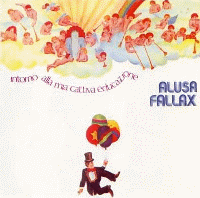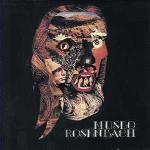 We need to
consider more carefully whether certain records are classics or not. Quella
Vecchia Locanda put out two LPs. Their eponymous effort of 1972 is very
often cited as a classic, and one does not wish to debate such opinions.
The second, Il Tempo Di Gioia, from 1974, receives negative comparisons
with the first, but is that fair or productive? Decidedly not, if the
second is a greater artistic achievement. There is some concern that the
second may be genuinely out of tune, whereas the first only falls under
mild suspicion. Yet the band makes a realistic effort to represent its
sometimes bizarre tunings as absolute pitch, and otherwise a high quality
of musicianship is pervasive. It may simply be that Il Tempo Di Gioia
requires more effort to appreciate. One will have to agree that its five
none-too-long tracks stack up well against the eight tracks of the first
LP, but I think that may be possible. Certainly they are all quite individual,
which cannot be said of the first. Then there is the strident quality
of this record, contrasting with the mellow atmosphere of the first. But
that’s the point, really, isn’t it. While the first LP seems
to know something about depth of good feeling, this one has a conception
of life as a whole, riddled with flaws, but strangely worth living.
We need to
consider more carefully whether certain records are classics or not. Quella
Vecchia Locanda put out two LPs. Their eponymous effort of 1972 is very
often cited as a classic, and one does not wish to debate such opinions.
The second, Il Tempo Di Gioia, from 1974, receives negative comparisons
with the first, but is that fair or productive? Decidedly not, if the
second is a greater artistic achievement. There is some concern that the
second may be genuinely out of tune, whereas the first only falls under
mild suspicion. Yet the band makes a realistic effort to represent its
sometimes bizarre tunings as absolute pitch, and otherwise a high quality
of musicianship is pervasive. It may simply be that Il Tempo Di Gioia
requires more effort to appreciate. One will have to agree that its five
none-too-long tracks stack up well against the eight tracks of the first
LP, but I think that may be possible. Certainly they are all quite individual,
which cannot be said of the first. Then there is the strident quality
of this record, contrasting with the mellow atmosphere of the first. But
that’s the point, really, isn’t it. While the first LP seems
to know something about depth of good feeling, this one has a conception
of life as a whole, riddled with flaws, but strangely worth living.
 Alusa Fallax
chose for themselves a very strange name, and they were a pop group, no
less, before they essayed into the progressive. According to my information
their name dates at least back to the dawn of Itaprog. I can see how it
might relate somehow to the name of their sole album, Intorno alla
mia cattiva educazione, which came out in 1974 and surely cannot have
been recorded long before its release. But an accurate interpretation
of the Alusa Fallax name would maybe require an Indo-European grammar
and some comic books. Sorry to disappoint you, then, on the issue of what
the name means. There’s no way of telling here that Alusa Fallax
was ever a pop group, and not for a New York minute would one hesitate
to term their album a classic of the Itaprog. The cover – one could
also say that the cover is truly among the greats – perhaps the best
of all Ita covers – and that’s really saying something. The
music has one annoying drawback: it features a ritornello. Didn’t
that kind of thing go out of fashion five centuries ago with Monteverdi?
But it doesn’t fit too badly, for the music is entirely continuous
except for an artificial break signalling the end of the first and beginning
of the second side. Intorno alla mia cattiva educazione provides
evidence that high art can result from a negative appreciation of the
norms of education.
Alusa Fallax
chose for themselves a very strange name, and they were a pop group, no
less, before they essayed into the progressive. According to my information
their name dates at least back to the dawn of Itaprog. I can see how it
might relate somehow to the name of their sole album, Intorno alla
mia cattiva educazione, which came out in 1974 and surely cannot have
been recorded long before its release. But an accurate interpretation
of the Alusa Fallax name would maybe require an Indo-European grammar
and some comic books. Sorry to disappoint you, then, on the issue of what
the name means. There’s no way of telling here that Alusa Fallax
was ever a pop group, and not for a New York minute would one hesitate
to term their album a classic of the Itaprog. The cover – one could
also say that the cover is truly among the greats – perhaps the best
of all Ita covers – and that’s really saying something. The
music has one annoying drawback: it features a ritornello. Didn’t
that kind of thing go out of fashion five centuries ago with Monteverdi?
But it doesn’t fit too badly, for the music is entirely continuous
except for an artificial break signalling the end of the first and beginning
of the second side. Intorno alla mia cattiva educazione provides
evidence that high art can result from a negative appreciation of the
norms of education.
 There is
no earthly reason to deny Museo Rosenbach classic status for their effort
of 1973 entitled Zarathustra. It is drawn from the purest fount
of the Italian progressive art. The music is lyrical, a fact that is far
too easily overlooked. Any possibility of levelling a charge of awkwardness
against transitional passages must be rejected on the grounds that transitions
lead generally once again into the mystical Zoroastrian realm that is
established at the outset. We are led to suspect that a genuine cult of
the Parsees is at play here somewhere, not just a rehash of the Zoroaster
of Nietzsche – but a resolution of this particular point hardly seems
necessary to our absorbing the musical experience. In any event, the chief
musical characteristic of this record is its exploitation of eastern tonalities
within an integrated progressive rock format. Throw in a heavy spiritual
undercurrent and you have something quite unique in the annals of Itaprog.
There is
no earthly reason to deny Museo Rosenbach classic status for their effort
of 1973 entitled Zarathustra. It is drawn from the purest fount
of the Italian progressive art. The music is lyrical, a fact that is far
too easily overlooked. Any possibility of levelling a charge of awkwardness
against transitional passages must be rejected on the grounds that transitions
lead generally once again into the mystical Zoroastrian realm that is
established at the outset. We are led to suspect that a genuine cult of
the Parsees is at play here somewhere, not just a rehash of the Zoroaster
of Nietzsche – but a resolution of this particular point hardly seems
necessary to our absorbing the musical experience. In any event, the chief
musical characteristic of this record is its exploitation of eastern tonalities
within an integrated progressive rock format. Throw in a heavy spiritual
undercurrent and you have something quite unique in the annals of Itaprog.
 A secret
masterpiece came out in 1973: Vietato ai minori di 18 anni? It
was the third Jumbo LP and reflects both practical experience and artistic
maturity. Originally Jumbo played blues-rock as a vehicle for their distinctive
singer, Alvaro Fella, and his wistful yet cynical conception of amore.
Then on the follow-up DNA, from 1972, they amazed the listening
public with their new-found progressive sound. Some call that one a masterpiece,
but one can only maintain such a standpoint, I think, by observing how
unlikely it was for a lusty, rusty outfit like Jumbo to play progressive,
yet how convincingly they manage it on DNA. On Vietato,
therefore, they are seeking to press this progressive identity into service,
and there is no shortage of fine material here. For Jumbo could draw on
all kinds of riffs and segues from popular music backgrounds. Sounds already
almost familiar yet contrasting sharply with each other appear in synchronization
with an ever varying combination of instruments. Yet no particular instrument
has a limited identity – except perhaps the singer himself, though
he too works with different textures on a variety of levels to serve the
blending of contrasting sounds that principally characterize this record.
A secret
masterpiece came out in 1973: Vietato ai minori di 18 anni? It
was the third Jumbo LP and reflects both practical experience and artistic
maturity. Originally Jumbo played blues-rock as a vehicle for their distinctive
singer, Alvaro Fella, and his wistful yet cynical conception of amore.
Then on the follow-up DNA, from 1972, they amazed the listening
public with their new-found progressive sound. Some call that one a masterpiece,
but one can only maintain such a standpoint, I think, by observing how
unlikely it was for a lusty, rusty outfit like Jumbo to play progressive,
yet how convincingly they manage it on DNA. On Vietato,
therefore, they are seeking to press this progressive identity into service,
and there is no shortage of fine material here. For Jumbo could draw on
all kinds of riffs and segues from popular music backgrounds. Sounds already
almost familiar yet contrasting sharply with each other appear in synchronization
with an ever varying combination of instruments. Yet no particular instrument
has a limited identity – except perhaps the singer himself, though
he too works with different textures on a variety of levels to serve the
blending of contrasting sounds that principally characterize this record.
 What’s
going on in this cover, that’s what I want to know. Is that Charon
punting the shades of the Maxophone across the River Styx? It sure looks
like it is. Does that mean there would never be any more Maxophone LPs
coming out after this eponymous one saw daylight in 1975? How could they
be so sure? What if one of the tracks had become an FM radio favorite
and somebody decided to put up money for another LP? What if one of the
band members assembled a new outfit and decided it would be appropriate
to use the Maxophone name? Nope, I guess we just have to accept that this
LP was deliberately intended to be the Maxophone’s first and last,
despite an interesting pop single the group put out some time after the
album. Actually, here you only see the six main guys in the group, but
several more (mostly girls) contributed to this album, and all kinds of
instruments can be heard. If there was ever such a thing as a progressive
rock orchestra, or even formal structures applying specifically to progressive
rock music, this is probably it right here.
What’s
going on in this cover, that’s what I want to know. Is that Charon
punting the shades of the Maxophone across the River Styx? It sure looks
like it is. Does that mean there would never be any more Maxophone LPs
coming out after this eponymous one saw daylight in 1975? How could they
be so sure? What if one of the tracks had become an FM radio favorite
and somebody decided to put up money for another LP? What if one of the
band members assembled a new outfit and decided it would be appropriate
to use the Maxophone name? Nope, I guess we just have to accept that this
LP was deliberately intended to be the Maxophone’s first and last,
despite an interesting pop single the group put out some time after the
album. Actually, here you only see the six main guys in the group, but
several more (mostly girls) contributed to this album, and all kinds of
instruments can be heard. If there was ever such a thing as a progressive
rock orchestra, or even formal structures applying specifically to progressive
rock music, this is probably it right here.